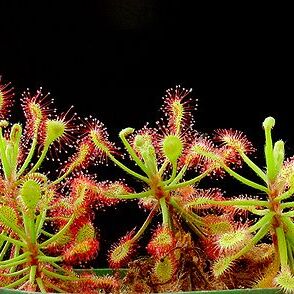Plants caulescent, half decumbent, occasionally stems suppressed. Roots poorly developed, 1-2, swollen. Stems thin, up to 25 cm long, covered with old leaf remains. Leaves alternate on the stems, occasionally clustered; petiole c. 3 cm, erect, reflexed with age, pilose; stipules 8 mm, membranous, ferruginous, entire, lacerated apically; lamina obovate to spathulate, 10-15 mm long, 7 mm broad, bearing only the knob-shaped tentacles; lower surface glabrous. Inflorescence axillary, near the apex of the stem, scape hooked below, 20-40 cm long, wiry, glabrous, rhachis glandular-pubescent; pedicels 1-3 mm, flowers 4-12, secund, small. Calyx lobes narrow, 4 mm long, with a few scattered setae. Petals obovate, c. 8 mm long, pink. Stamens short, with the connective slightly swollen. Styles forked near the base, stigmatic apices clavate to somewhat bilobed. Capsule oblong; seeds fusiform with the elongated testa forming a foot and an apiculus, 0.6 mm, papillate-beaded. Flowering during the summer months.
Perennial, insectivorous herb, 200-250 mm high, caulescent, half decumbent. Leaves with lamina obovate to spathulate, 10-15 x 7 mm; stipules membranous, ferruginous; petioles ± 30 mm long, reflexed with age. Flowers 4-12 on an axillary, wiry scape, 200-400 mm high, strongly curved below, pink; stigmatic apices clavate to somewhat bilobed. Flowering time summer months. Fruit an oblong capsule. Seeds fusiform.
Leaves alternate, clustered and erect at the top of the stem, but deflexed lower down; lamina 0·5–1·5 x 0·2–0·5 cm., elliptic, obovate or spathulate, glandular, especially towards the margins above, sparsely pilose below; stipules up to 5 x 1 mm., oblong, lacerated at the apex; petioles 1–3 x 0·03–0·1 cm., glabrous or pilose above, usually pilose (rarely glabrous) below.
Perennial herb, 0.20-0.25 m, caulescent. Stems thin, covered with old leaf remains. Leaves alternate on stems; petiolate; blade only with terete tentacles, tipped with knob-shaped glands, distinct from petiole; petiole ± 30 mm long. Flowers: in an inflorescence 20-40 mm long; petals pink; Dec.-Feb. Fruit oblong.
Caulescent herb, half decumbent, stems occasionally suppressed. Stipules present, conspicuous. Leaves petiolate, leaf blade distinct from petiole. Cyme simple, helicoid. Scapes sharply curved at base. Flowers pink.
Peduncles 1–2, 9–55 cm. long, arising laterally below the top of the stem, then curving to become erect, glabrous, glandular or pilose.
Inflorescence 2–14-flowered; pedicels 1–10 mm. long, glandular or pilose; bracts 3 mm. long, linear, sparsely pilose, caducous.
Seeds 0·7–0·9 x 0·2 mm., brownish-black, fusiform; testa reticulate, with longitudinal and transverse ridges.
Perennial herb, caulescent, but occasionally apparently acaulescent by reduction; stem up to 25 cm. long.
Sepals 5, 4–7 x 1–2 mm., connate at the base, elliptic or oblong-lanceolate, glandular-pilose.
Ovary subglobose, glabrous; styles 3, 2 mm. long, 2-partite to the base, apices clavate.
Petals 5, 5–8 mm. long, pink or purple.
Stamens 5, filaments 5 mm. long.
Flowers pink.


